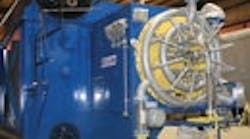For years, Olin Chlor Chemicals relied on a neighboring facility to supply steam to its manufacturing operations in Niagara Falls, N.Y. But in 2001, Olin’s steam supplier announced that it would be closing its facility.
This posed a significant problem for Olin, a division of Olin Corp., Clayton, Mo. As a manufacturer of chlorine and caustic soda, hydrochloric acid, hydrogen and bleach products, the company relies on steam for manufacturing processes and heating. Olin’s facility managers quickly set out to find a supplier for a new boiler system.
At the time, Olin was producing an excess of hydrogen as a byproduct. They used part of that hydrogen in the process, and were selling some of it. But because it’s difficult to store, excess hydrogen was vented. The Olin team realized they could substantially reduce their annual fuel costs and be more environmentally friendly by burning the wasted hydrogen because hydrogen combustion doesn’t produce carbon dioxide.
Olin can use the steam produced with the hydrogen for the manufacturing process and for building heat. This is even more beneficial when the cost of natural gas and oil reaches peak levels.
After researching boiler manufacturers, Olin’s facility engineers decided to contract with C-B Nebraska Boiler and C-B NATCOM, the watertube boiler and burner divisions of Cleaver-Brooks (www.cleaverbrooks.com) to install two industrial watertube boilers, each capable of 75,000 pounds per hour (PPH) with operating pressures of 150 psig.
Because the hydrogen is process byproduct, its availability isn’t constant, so Olin wanted a system that could fire hydrogen and natural gas or #2 oil. To maximize the savings, Olin wanted the boiler burners to be efficient at both low fire and high fire.
A system typically uses a flow-control valve to reduce available flow and pressure for a reduced firing rate, but the available hydrogen pressure was limited to 7 psig. To fire hydrogen safely, it’s essential to maintain a minimum velocity at the hydrogen injectors, so conventional flow and pressure control isn’t sufficient. C-B NATCOM designed a burner that uses multiple hydrogen injection zones that are opened and closed to keep the fuel pressure within usable limits. A system of six zones meets the targeted 20:1 turndown ratio.
Conventional systems use high differential pressure to generate a representative flow signal throughout the turndown range, but with such low hydrogen supply pressure and high turndown ratio, the flow elements had to be designed to minimize pressure drop. C-B worked with the instrumentation supplier to develop a split-range strategy for the flow elements to ensure safe, accurate flow signals with minimal pressure loss throughout the firing range.
Finally, the burner management system (BMS) and combustion control system (CCS) were developed to safely and efficiently manage five individual firing modes: natural gas only, #2 oil only, hydrogen only, hydrogen with natural gas and hydrogen with #2 oil. The system has an 8-in. hydrogen main train and a 3-in. low-flow bypass for partial-load hydrogen flow measurement.
As previously mentioned, an added benefit of burning hydrogen is that it’s a clean fuel, but it also burns rapidly, which produces high levels of thermal NOx (in excess of 300 ppm). Olin’s targeted NOx when firing hydrogen was 0.1 lb/MMBTU (110 ppm).
To accommodate Olin’s targeted NOx requirement, the burner featured Hyper-Shield technology, which injects steam around the periphery of the hydrogen injectors to shield the fuel from immediate contact with the combustion air. This results in staged burning and reduces NOx formation. NOx emissions firing hydrogen with sustaining natural gas are 72 ppm, well below the targeted 110 ppm limit.
When burning other fuels — natural gas and #2 oil — it achieves low NOx levels of 40 ppm and 110 ppm.
Firing hydrogen usually means high burner maintenance. The rapid combustion often allows the flame to contact the burner components, leading to quick degradation. To date, Olin hasn’t needed to change a single hydrogen-firing burner component.
The project required about 14 months to complete. Along with the reduction in carbon footprint, the facility is saving about $2.5 million per year because it can burn alternative fuel. With volatile fuel prices, this project’s benefits are rising year after year.
To achieve results like these, a manufacturer doesn’t necessarily have to invest in a new boiler system. If a boiler system has been well maintained, there are retrofit options available that allow the system to burn alternative fuels, reduce NOx emissions and lower energy bills.
